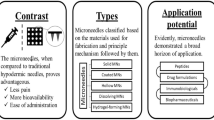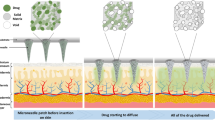Abstract
Microneedle delivery patches are an emerging technology to attain painless and sustained delivery through the epidermis of the skin. This study is unique in its attempt to develop polymeric microneedles embedded with drug. Special polymer chitosan with hydrogel forming capability is cross-linked with PVA, a water-soluble polymer with excellent film strengthening ability and loaded with model drug diclofenac sodium. The microneedle patch was fabricated by pouring the chitosan-PVA solution (ratio 1:6) on negative replica of master mold, which upon drying was peeled off to result in the composite film. The film of chitosan-PVA in the ratio 1:6 when tested for mechanical behavior exhibited improved mechanical strength owing to use of PVA, the presence of effective cross-linking of PVA with chitosan was further verified with FTIR. The release from drug-loaded needles was promising, as cross-linking with PVA enabled a sustained drug release of 20.17% at the end of 30 h. The release followed the Higuchi model with Fickian diffusion, indicating a swelling-dependent release. The microneedle prepared using a composite of chitosan-PVA showed promising results indicating its potential to be used as a drug eluting transdermal patch.



Similar content being viewed by others
References
Abraham PA, Soloman PO (2016) Rejini. Procedia Tech 24:741
Bahrami SB, Kordestani SS, Hamid M, Parvin M (2003) Poly(vinyl alcohol)—chitosan blends: preparation, mechanical and physical properties. Iran Polym J 12(2003):139
Bahrami SB, Kordestani SS, Mirzadeh H, Mansoori P (2003) Poly (vinyl alcohol)-chitosan blends: preparation, mechanical and physical properties. Iran Polym J 12:139
Brazzle D, Bartholomeusz R, Davies J, Andrade J, Wageman RAV, Frazier AB (2000) Active microneedles with integrated functionality. In: Proceedings of solid state sensor and actuator workshop, Hilton Head, pp 192–202
Cheikh D, García-Villén F, Majdoub H, Zayania MB, Viseras C (2019) Appl Clay Sci 172:155
Choi MJ, Park JY, Cha KJ, Rhie JW, Cho DW, Kim DS (2012) Micropattern array with gradient size (µPAGS) plastic surfaces fabricated by PDMS (polydimethylsiloxane) mold-based hot embossing technique for investigation of cell-surface interaction. Biofabrication 4:1
Costa P, Lobo JMS (2001) Modeling and comparison of dissolution profiles. Eur J Pharm Sci 13:123
DeMuth PC, Su X, Samuel RE, Hammond PT, Irvine DJ (2010) Nano-layered microneedles for transcutaneous delivery of polymer nanoparticles and plasmid DNA. J Adv Mater 22:4851
Donnelly RF, Singh TR, Woolfson AD (2010) Microneedle-based drug delivery systems: microfabrication, drug delivery, and safety. Drug Deliv 17:187
El-Hefian EA, Nasef MM, Yahaya AH (2010) The preparation and characterization of Chitosan Poly(vinyl alcohol) blended films. J Chem 7:1212
Gittard SD, Ovsianikov A, Monterio-Rivere NA, Lusk J, Morel P, Minghetti P, Lenardi C, Chichkov BN, Narayan RJJ (2009) Fabrication of polymer microneedles using a two-photon polymerization and micromolding process. J Diabetes Sci Technol 3:304
Han M, Hyun D-H, Park H-H, Lee SS, Kim C-H, Kim CJ (2007) Anoble fabrication process for out-of-plane microneedle sheets of biocompatible polymer. J Micromech Microeng 17:1184
Heckele M, Schomburg WKJ (2004) Review on micro molding of thermoplastic polymers. J Micromech Microeng 14:R1
Higuchi T (1961) Rate of release of medicaments from ointment bases containing drugs in suspension. J Pharm Sci 50:874
Jadhav RT, Kasture PV, Gattani SG, Surana SJ (2009) Formulation and evaluation of transdermal films of diclofenac sodium. Int J PharmTech Res 1(2009):1507
Kaushik S, Hord AH, Denson DD, McAllister DV, Smitra S et al (2001) Lack of pain associated with microfabricated microneedles. Anesth Analg 92:502
Korkiatithaweechai S, Umsarika P, Praphairaksit N, Muangsin N (2011) Controlled release of diclofenac from matrix polymer of chitosan and oxidized konjac glucomannan. Mar Drugs 9:1649
Korytkowski M, Niskanen L, Asakura T (2005) FlexPen: addressing issues of confidence and convenience in insulin delivery. Clin Ther 27:S89
Lee JW, Choi SO, Felner EI, Prausnitz MR (2011) Dissolving microneedle patch for transdermal delivery of human growth hormone. Small 7:531
Levine MM (2003) Can needle-free administration of vaccines become the norm in global immunization? Nat Med 9:99
Lin L, Pisano AP (1999) Silicon-processed microneedles. J Microelectromech Syst 8:178
Miller MA, Pisani E (1999) The cost of unsafe injections. World Health Organ 77(10):808
Moon SJ, Jin CY, Lee SS (2006) A novel method of microneedle array fabrication using inclined deep x-ray exposure. J Phys Conf Ser 34:180
Owens DR, Zinman B, Bolli G (2003) Alternative routes of insulin delivery. Diabet Med 20:886
Parker ER, Rao MP, Turner KL, Meinhart CD, MacDonald NCJ (2007) Bulk Micromach Titan Microneedles 16:289
Prausnitz MR (2004) Microneedles for transdermal drug delivery. Adv.Drug Deliv Rev 56:581
Reed ML, Lye WK (2004) Microsystems for drug and gene delivery. In: Proceedings of the IEEE, vol 92, no. 1, pp 56–75
Rogers JA, Bao Z, Baldwin K, Dodabalapur A, Crone B, Raju VR, Kuck V, Katz H, Amundson K, Ewing J, Drzaic P (2001) Paper-like electronic displays: large-area rubber-stamped plastic sheets of electronics and microencapsulated electrophoretic inks. Proc Natl Acad Sci USA 98:4835
Sammoura F, Kang JJ, Heo YM, Jung T, Lin L (2007) Polymeric microneedle fabrication using a microinjection molding technique. Microsyst Technol 13:517
Simonsen L, Kane A, Lloyd J, Zaffran M, Kane M (1999) Unsafe injections in the developing world and transmission of bloodborne pathogens: a review. World Health Organ 77:789
Sivamani RK, Stoeber B, Wu GC, Zhai H, Liepmann D, Maibach H (2005) Clinical microneedle injection of methyl nicotinate: Stratum corneum penetration. Skin Res Tech 11:152
Stoeber B, Liepmann P (2000) Fluid injection through out-of-place microneedles. In: 1st annual international IEEE-EMBS special topic conference on microtechnologies in medicine and biology. Lyon, France, pp 224–228
Stupar PA, Pisano AP (2001) Silicon, parylene, and silicon/parylene microneedles for strength and toughness. In: Obermeier E (ed) Proceedings of the 11th international conference on solid-state sensors and actuators (Transducers ‘01 Eurosensors XV). Springer, Berlin, pp 1386–1389
Teo AL, Shearwood C, Ng KC, Lu J, Moochhala S (2006) Transdermal microneedles for drug delivery applications. Mater Sci Eng B 132:151
Tomono T (2019) A new way to control the internal structure of microneedles: a case of chitosan lactate. Mater Today Chem 13:79
Wang T, Turhan M, Gunasekaran S (2004) Selected properties of pH-sensitive, biodegradable chitosan–poly(vinyl alcohol) hydrogel. Polym Int 53:911
Wang Q, Du YM, Fan LH (2005) Properties of chitosan/poly (vinyl alcohol) films for drug controlled release. Appl Polym Sci 96:808–813
Wang Q, Xie X, Zhang X, Zhang J, Wang A (2010) Preparation and swelling properties of pH-sensitive composite hydrogel beads based on chitosan-g-poly (acrylic acid)/vermiculite and sodium alginate for diclofenac controlled release. Inter J Biol Macromol 46:356
Acknowledgements
The authors sincerely acknowledge Mr. Shivanand.M.Shettigar, Manipal College of Pharmaceutical Sciences, Manipal and Dr. N.V Anil Kumar, Manipal Institute of Technology, Manipal for their technical support. One of the author would like to acknowledge the funding from Vision Group of Science and Technology (VGST), No. VGST/SMYSR (2014-15)/GRD-448/2015-16 from Govt. of Karnataka, India. Authors sincerely acknowledge Dr. V.H.S.Moorthy and Mr. Venkatesh A of Research laboratory for Plasmonics and Fiona Concy Rodrigues, Department of Biomedical Engineering for their technical support. The authors are grateful for the funding from Manipal University (MIT/AD-R&C/Post Doc/2012, dated 30.11.2012).
Author information
Authors and Affiliations
Corresponding author
Ethics declarations
Conflict of interest
Authors declare there is no conflict of interest.
Additional information
Publisher's Note
Springer Nature remains neutral with regard to jurisdictional claims in published maps and institutional affiliations.
Rights and permissions
About this article
Cite this article
Dathathri, E., Lal, S., Mittal, M. et al. Fabrication of low-cost composite polymer-based micro needle patch for transdermal drug delivery. Appl Nanosci 10, 371–377 (2020). https://doi.org/10.1007/s13204-019-01190-3
Received:
Accepted:
Published:
Issue Date:
DOI: https://doi.org/10.1007/s13204-019-01190-3




